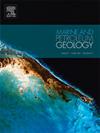An innovative seismo-petrophysical characterization of a turbidite sand in the Nam Con Son Basin, using permeability-linked adaptive rock physics template (K-ARPT) with reference to gas exploration and carbon storage
IF 3.7
2区 地球科学
Q1 GEOSCIENCES, MULTIDISCIPLINARY
引用次数: 0
Abstract
The MMF30 turbidite sand in the Hai Thach-Moc Tinh (HT-MT) field, Nam Con Son basin (NCSB), Vietnam, is a significant gas condensate-producing reservoir. However, the variable and high cementation make its reservoir characterization particularly challenging. With the declining production observed in many fields in the NCSB since 2018 one needs to think not only of exploring more hydrocarbon reservoirs, but also how to make use of depleted reservoirs for carbon storage in the near future.
In this study, we successfully conducted a comprehensive seismo-petrophysical characterization of a deep-seated, highly-cemented sand (MMF30) by integrating core testing, well log analysis, rock physical modeling and prestack seismic inversion. The predominant types of cementation of the study sand are quartz-overgrowth, clayey, and calcite, which altogether make a high percentage of up to 10%. The sand porosity was found to be from 11 to 17% and gas saturation from 50% up. An innovative contribution of this study is the successful proposal and construction of a new type of rock physics template named the permeability-linked adaptive rock physics template (K-ARPT) to help identify more in details the permeable subzones within the depleted gas reservoir. To construct K-ARPT, different permeability prediction models were tried, both traditional and machine learning-based, among which the random forest (RF) method proved to be the best for the study sand based on cross-validation with the available core measurements. As results of seismo-petrophysical characterization, five lithological units of shale and gas sand were identified in the MMF30 reservoir interval with porosity from 11 to 17%, gas saturation from 50% up and permeability from less than 0.5 to 50 mD, among which the unit of 20–50 mD would be the most suitable for carbon injection and storage.
求助全文
约1分钟内获得全文
求助全文
来源期刊

Marine and Petroleum Geology
地学-地球科学综合
CiteScore
8.80
自引率
14.30%
发文量
475
审稿时长
63 days
期刊介绍:
Marine and Petroleum Geology is the pre-eminent international forum for the exchange of multidisciplinary concepts, interpretations and techniques for all concerned with marine and petroleum geology in industry, government and academia. Rapid bimonthly publication allows early communications of papers or short communications to the geoscience community.
Marine and Petroleum Geology is essential reading for geologists, geophysicists and explorationists in industry, government and academia working in the following areas: marine geology; basin analysis and evaluation; organic geochemistry; reserve/resource estimation; seismic stratigraphy; thermal models of basic evolution; sedimentary geology; continental margins; geophysical interpretation; structural geology/tectonics; formation evaluation techniques; well logging.
 求助内容:
求助内容: 应助结果提醒方式:
应助结果提醒方式:


